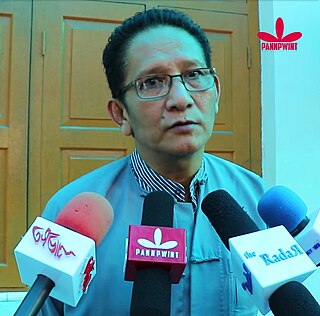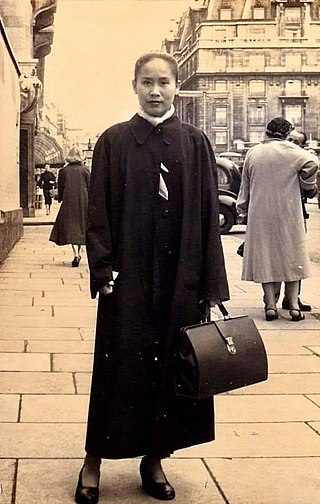Related Research Articles

The National Anthem is the national anthem of Myanmar. It consists of two parts; the first half is a traditional Burmese style section, before transitioning into the second half, a Western-style orchestra. Because of the second half, both the "National Anthem" and its predecessor "Dobama Song" are popularly known as "Kaba Ma Kyei".

The Ministry of Sports and Youth Affairs administers Myanmar sports and youth affairs. The ministry was formed in 1996 as Ministry of Sports and organized as Ministry of Health and Sports in 2016. In 2021, following the formation of a caretaker government, the ministry was reorganized as Ministry of Sports and Youth Affairs. The current union minister is Min Thein Zan, appointed by SAC Chairman Min Aung Hlaing.
Maung Weik is a Burmese tycoon. He is currently chairman of the Mandalay Business Capital City Development (MBCCD) and the Sae Paing Company.
The Venerable Taung Kalay Sayadaw Ashin Paññasãmi is a Karen Buddhist monk, and also known as a prolific writer and historian.

Zin Wine is a Burmese film actor. He won the Myanmar Motion Picture Academy Awards two times and served as the chairperson of the Myanmar Motion Picture Organization twice as well.
Bogalay Tint Aung was a Burmese composer, director and writer. The first recipient of the Myanmar Academy Award for lifetime achievement, Tint Aung was a patron of the Myanmar Motion Picture Organisation.
Thiri Maha Thuta Yadana Sanda Dewi, commonly known as Anauk Nanmadaw Ma Mya Lay, was the Queen of the Western Palace of King Tharrawaddy during the Konbaung dynasty.
Maung Maung San, also known by his pen names Kyi Min and Kyaw Saw Min (ကျော်စောမင်း), is a Burmese writer and a former veterinary physician. He has served as Rector and Pro-rector of the University of Veterinary Science, Yezin. He is a former senior member of Myanmar Press Council.

Yindaw Ma Lay was a Burmese royal court dancer, best known during the late Konbaung era. Yindaw Ma Lay is said to be one of the two mothers of the Mandalay's first dramatic arts era along with Sin Kho Ma Lay, her only contemporary court dancer.
Taungdwin Shin Nyein Me was an early 18th century Burmese poet, best known for introducing the ainggyin, a type of Burmese folksong. She composed several ainggyins, which remain a reflection of the late Restored Toungoo (Nyaungyan) period.
Ainggyin is a Burmese form of poetry which is often referred as a kind of folk-song. Ainggyins are said to be the reflections of the rural culture of Burma. Ainggyin was first started in the First Kingdom of Ava and later developed in the Nyaungyan period and continued to the Konbaung period.
Hteiktin Pu, commonly known as Prince of Pyinzi, was a royal prince during the late Konbaung dynasty, especially famous for his classical Mahāgīta songs.
Minye Thihakyaw, commonly known as the Prince of Pyinzi, was a royal prince during the Konbaung dynasty, especially renowned for his composition of classical songs.
Me Khway was a Burmese poet during the reigns of King Bodawpaya to King Tharrawaddy. She is regarded as the first composer of 12-month celebration egyins. Since she had composed many egyins, she is also known as E Me Khway.
Bala Pyan was a 20th-century Burmese Aka Weizza who invented the Sandawgyein Aka. She was believed to be the reincarnation of Aung Bala, who was also a dancer.

Kyan, known honorifically as Daw Kyan, was a Burmese historian and writer who specialized in the history of Burma under British colony. She received two civil orders, two lifetime achievement awards, six literary awards and three outstanding women awards, and was remembered as the Centenary History Devi of Burma.
Prince of Pyinzi was a hereditary title given to the royal prince who was granted the appanage of Pyinzi as liege-lord or myosa, which is equivalent to a duke.

Chit Thet Wai is a 1952 Burmese black-and-white romantic-drama film, directed by Tin Maung starring Tin Maung, Kyi Kyi Htay, Thein Zaw and May Lwin.
Phyu Gyi was a Burmese boxer and Lethwei fighter from Burma. He is a former multiple-time flag champion.
Thway Thit Win Hlaing is a Burmese Lethwei fighter and current openweight Lethwei world Champion. He is known as counter fighter relying on counters rather than straight offence.
References
- ↑ "ဧချင်းထဲက မဟာသီရိဇေယျသူရ မင်းကြီးညို". MDN - Myanmar DigitalNews (in Burmese).
- 1 2 လှိုင်း (မောင်), ယဉ် (2007). ဘုရင့်နောင်မင်းတရားကြီး၏ ဟံသာဝတီခေတ် ယဉ်ကျေးမှု (in Burmese). ပုံနှိပ်ရေးနှင့် စာပေထုတ်ဝေရေးလုပ်ငန်း.
- 1 2 Charney, Michael W. (July 2002). "Centralizing Historical Tradition in Precolonial Burma: The Abhiraja/Dhajaraja Myth in Early Kòn-Baung Historical Texts". South East Asia Research. 10 (2): 185–215. doi:10.5367/000000002101297053. ISSN 0967-828X.
- ↑ သူ, ထီလာစစ် (1998). Critiques on Myanmar Poetry: An Appreciation (in Burmese). Moe Min Sarpay.
- ↑ စာဆိုတော်များ အတ္ထုပတ္တိ (in Burmese). လောကစာပေ. 2002.
- ↑ "ဧချင်းများထဲမှ လူဝင်စားများ". MDN - Myanmar DigitalNews (in Burmese).
- ↑ ဦး), ထွန်းညို (တွင်းသင်းတိုက်ဝန် မဟာစည်သူ (2007). မဟာရာဇဝင်သစ်: တောင်ငူဆက် (in Burmese). အားမာန်သစ်စာပေ.
- ↑ ဩ, ရွှေဥ. (2001). မြန်မာစာဆိုတော်များ (in Burmese). စစ်သည်တော်စာပေ.
- ↑ လျင်), မြဦး (သန် (1994). ပန်တျာဂီတလမ်းညွှန် (in Burmese). စာပေဗိမာန်.
- ↑ မြန်မာ့စစ်သွေး၊ မြန်မာ့စစ်ရေး (in Burmese). ကာကွယ်ရေးဝန်ကြီးဌာန၊ လေ့ကျင့်ရေး ညွှန်ကြားရေးမှူးရုံး. 1994.